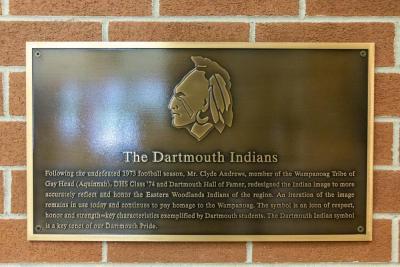Beyond the icon: Dartmouth takes steps in furthering indigenous education
When Dartmouth voters overwhelmingly chose to affirm the high school’s Indian name and logo in this year’s town election, many did so with the stipulation that they would like to see the town find additional ways to honor the culture and history of those who once inhabited these lands.
To that effect, the town has gotten to work establishing a cultural committee consisting of town and school officials who have been in talks with members of local tribes on just how to do that.
“It goes beyond the [school] icon,” said committee member Heidi Brooks, who also serves on the Select Board. “We need to know why we are proud of our heritage as landholders of formerly native land.”
Recently, the committee held a Zoom meeting with Annawon Weeden, a member of the Mashpee Wampanoag tribe who helped set up the “Wampanoag Experience Powwow” held at Round the Bend Farm this past September.
During the meeting, Weeden provided officials with some suggestions on how to bolster indigenous education, including teaching about colonial interactions with tribes and traditional customs such as animal butchering.
Currently, Native American history is primarily taught at the third grade-level under the topic of “indigenous justice” in Dartmouth’s public schools, although Director of Elementary Level Teaching and Learning Catherine Pavao said the district is working on integrating things into the literacy curriculum.
Still, she said, there is “room for growth.”
One suggestion Weeden had was to teach more about King Philip's War, a 17-th century conflict in New England that saw more than 2,500 colonists, and at least twice that number of native people, killed.
What is now Dartmouth saw some of that action, with colonists finding refuge at the Russell homestead, now known as the Russell Garrison. In 1675, a group of Native Americans surrendered their weapons and sought refuge at the site, but were later taken to Plymouth where they were sold into slavery.
“I think [the topic] would fit perfectly with fifth grade and on,” Weeden said. “I can definitely see high school students [also] being involved in this learning experience.”
Weeden also highlighted some rather immersive classwork done in schools in Alaska. He noted that students at a high school in Anchorage learn how to gut, clean, and process seals.
“I saw this one white girl you would not expect to be cleaning the intestines, literally squeezing it — it was really powerful to see,” he said. “Literally every student had to go through that process. And they were not being disrespectful.”
Weeden added that Dartmouth could potentially incorporate similar lessons on traditional Native American activities in its schools.
Another way to further indigenous education, said Director of Secondary Level Teaching and Learning Ross Thilbault, is to have instructors meet with tribal members and discuss how to properly incorporate that framework.
“That’s really where we can impact change,” he said.
Officials also seek to expand education beyond the classroom.
The primary way they hope to achieve this is through a cultural event similar to the Powwow held at Round the Bend. Ideally, officials want something that could be held over some time in spring 2023.
One idea suggested by Brooks is inviting tribal members to participate in the town’s annual Memorial Day parade to do a blessing at the Padanaram bridge and Elm Street cemetery.
“And thousands of people can see it,” concurred Select Board Chair David Tatelbaum.
Another possibility, suggested by Weeden, is to gather with tribal members to remove plants like phragmites — a European invasive species — from Dartmouth’s marshes and the Slocum River.
“It destroys any environment that it takes over or encroaches upon,” he said.
Cleanups would serve as a way to learn more about local plant species indigenous people have used for healing purposes for thousands of years: cattails and sassafras.
“The colonists thought that stuff could cure everything,” Weeden said.
While there is eagerness to get something done, officials still want to take some time before making any final decisions.
“We don’t want it to happen overnight, we want to do it right,” Brooks said.
Other steps the town has taken involve the unveiling of a plaque at Dartmouth High dedicated to the logo of the Eastern Woodlands Indian created by Aquinnah Wampanoag Clyde Andrews in the 1970s. Additionally, students at the Greater New Bedford Regional Vocational Technical High School are also working on information kiosks to be put up around town, Brooks said.
As officials move forward on finding ways to honor Dartmouth’s indigenous past, the town is seeking Native American residents to join the new cultural committee. Those interested in joining can contact the Select Board office by emailing selectboard@town.dartmouth.ma.us or by calling (508) 910-1813.












